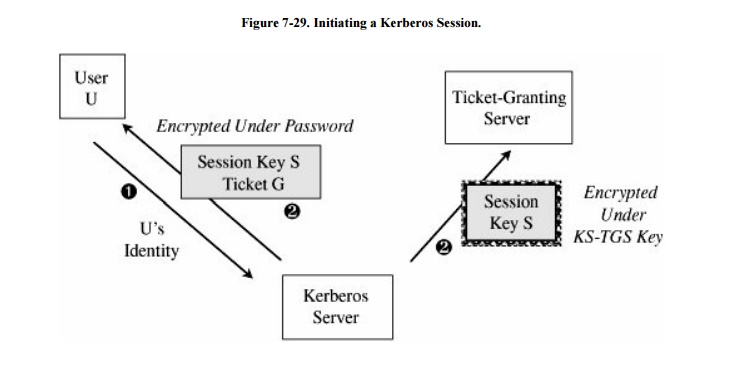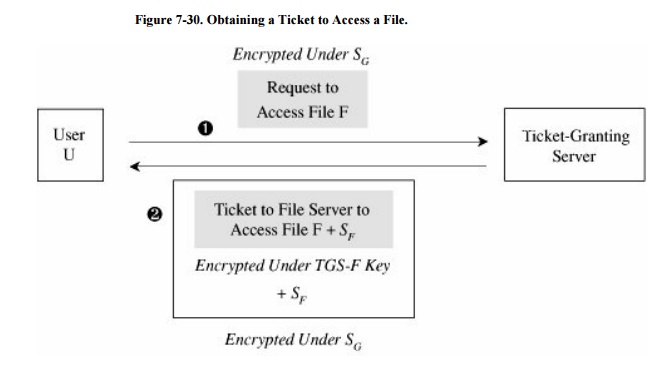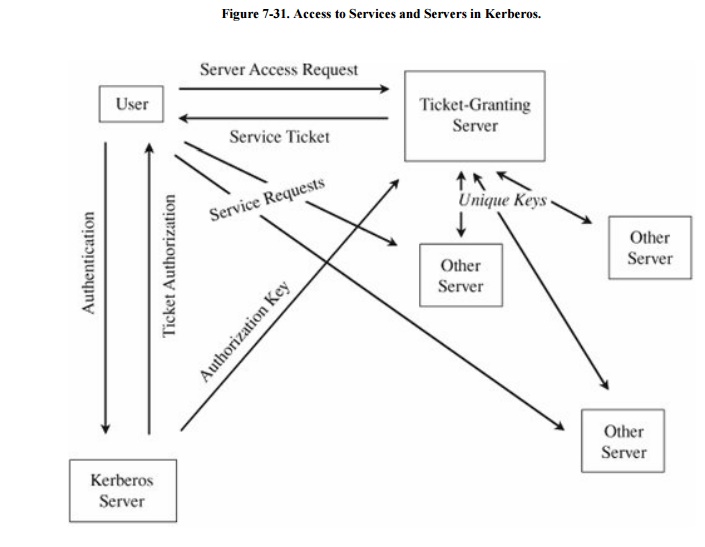Chapter: Security in Computing : Security in Networks
Strong Authentication and Kerberos - Security in Networks
Strong Authentication
As we have seen in earlier
chapters, operating systems and database management systems enforce a security
policy that specifies whowhich individuals, groups, subjectscan access which resources
and objects. Central to that policy is authentication: knowing and being
assured of the accuracy of identities.
Networked environments need
authentication, too. In the network case, however, authentication may be more
difficult to achieve securely because of the possibility of eavesdropping and
wiretapping, which are less common in nonnetworked environments. Also, both
ends of a communication may need to be authenticated to each other: Before you
send your password across a network, you want to know that you are really
communicating with the remote host you expect. Lampson [LAM00] presents the problem of authentication in
autonomous, distributed systems; the real problem, he points out, is how to
develop trust of network entities with which you have no basis for a
relationship. Let us look more closely at authentication methods appropriate
for use in networks.
One-Time Password
The wiretap threat implies
that a password could be intercepted from a user who enters a password across
an unsecured network. A one-time password can guard against wiretapping and
spoofing of a remote host.
As the name implies, a one-time password is good for one use
only. To see how it works, consider the easiest case, in which the user and
host both have access to identical lists of passwords, like the one-time pad
for cryptography from Chapter 2. The
user would enter the first password for the first login, the next one for the
next login, and so forth. As long as the password lists remained secret and as
long as no one could guess one password from another, a password obtained
through wiretapping would be useless. However, as with the one-time
cryptographic pads, humans have trouble maintaining these password lists.
To address this problem, we
can use a password token, a device
that generates a password that is unpredictable but that can be validated on
the receiving end. The simplest form of password token is a synchronous one,
such as the SecurID device from RSA Security, Inc. This device displays a
random number, generating a new number every minute. Each user is issued a
different device (that generates a different random number sequence). The user
reads the number from the device's display and types it in as a one-time
password. The computer on the receiving end executes the algorithm to generate
the password appropriate for the current minute; if the user's password matches
the one computed remotely, the user is authenticated. Because the devices may
get out of alignment if one clock runs slightly faster than the other, these
devices use fairly natural rules to account for minor drift.
What are the advantages and
disadvantages of this approach? First, it is easy to use. It largely counters
the possibility of a wiretapper reusing a password. With a strong
password-generating algorithm, it is immune to spoofing. However, the system
fails if the user loses the generating device or, worse, if the device falls
into an attacker's hands. Because a new password is generated only once a
minute, there is a small (one-minute) window of vulnerability during which an
eavesdropper can reuse an intercepted password.
ChallengeResponse Systems
To counter the loss and reuse
problems, a more sophisticated one-time password scheme uses challenge and
response, as we first studied in Chapter 4. A challenge and response device looks like a simple
pocket calculator. The user first authenticates to the device, usually by means of a PIN. The remote
system sends a random number, called the "challenge," which the user
enters into the device. The device responds to that number with another number,
which the user then transmits to the system.
The system prompts the user
with a new challenge for each use. Thus, this device eliminates the small
window of vulnerability in which a user could reuse a time-sensitive
authenticator. A generator that falls into the wrong hands is useless without
the PIN. However, the user must always have the response generator to log in,
and a broken device denies service to the user. Finally, these devices do not
address the possibility of a rogue remote host.
Digital Distributed Authentication
In the 1980s, Digital
Equipment Corporation recognized the problem of needing to authenticate
nonhuman entities in a computing system. For example, a process might retrieve
a user query, which it then reformats, perhaps limits, and submits to a
database manager. Both the database manager and the query processor want to be
sure that a particular communication channel is authentic between the two.
Neither of these servers is running under the direct control or supervision of
a human (although each process was, of course, somehow initiated by a human).
Human forms of access control are thus inappropriate.
Digital [GAS89, GAS90]
created a simple architecture for this requirement, effective against the
following threats:
·
impersonation of a server by a rogue
process, for either of the two servers involved in the authentication
·
interception or modification of data exchanged between servers
·
replay of a previous authentication
The architecture assumes that
each server has its own private key and that the corresponding public key is
available to or held by every other process that might need to establish an
authenticated channel. To begin an authenticated communication between server A
and server B, A sends a request to B, encrypted under B's public key. B
decrypts the request and replies with a message encrypted under A's public key.
To avoid replay, A and B can append a random number to the message to be
encrypted.
A and B can establish a private
channel by one of them choosing an encryption key (for a secret key algorithm)
and sending it to the other in the authenticating message. Once the
authentication is complete, all communication under that secret key can be
assumed to be as secure as was the original dual public key exchange. To
protect the privacy of the channel, Gasser recommends a separate cryptographic
processor, such as a smart card, so that private keys are never exposed outside
the processor.
Two implementation
difficulties remain to be solved: (a) How can a potentially large number of
public keys be distributed and (b) how can the public keys be distributed in a
way that ensures the secure binding of a process with the key? Digital
recognized that a key server (perhaps with multiple replications) was necessary
to distribute keys. The second difficulty is addressed with certificates and a
certification hierarchy, as described in Chapter 2.
Both of these design
decisions are to a certain degree implied by the nature of the rest of the
protocol. A different approach was taken by Kerberos, as we see in the
following sections.
Kerberos
As we introduced in Chapter 4, Kerberos is a system that supports
authentication in distributed systems. Originally designed to work with secret
key encryption, Kerberos, in its latest version, uses public key technology to
support key exchange. The Kerberos system was designed at Massachusetts
Institute of Technology [STE88, KOH93].
Kerberos is used for
authentication between intelligent processes, such as client-to-server tasks,
or a user's workstation to other hosts. Kerberos is based on the idea that a
central server provides authenticated tokens, called tickets, to requesting applications. A ticket is an unforgeable,
nonreplayable, authenticated object. That is, it is an encrypted data structure
naming a user and a service that user is allowed to obtain. It also contains a
time value and some control information.
The first step in using
Kerberos is to establish a session with the Kerberos server, as shown in Figure 7-29. A user's workstation sends the
user's identity to the Kerberos server when a user logs in. The Kerberos server
verifies that the user is authorized. The Kerberos server sends two messages:
to the user's workstation, a session key SG for use in communication with the ticket-granting server (G) and a ticket TG for the ticket-granting server; SG is encrypted under the user's password: E(SG + TG, pw)
to the ticket-granting server, a copy of the session key SG and the identity of the user (encrypted under a key shared between the Kerberos server and the ticket-granting server)

If the workstation can decrypt E(SG
+ TG, pw) by using pw, the password typed by the user, then the user
has succeeded in an authentication with the workstation.
Notice that passwords are stored at the
Kerberos server, not at the workstation, and that the user's password did not
have to be passed across the network, even in encrypted form. Holding passwords
centrally but not passing them across the network is a security advantage.
Next, the user will want to exercise some other
services of the distributed system, such as accessing a file. Using the key SG
provided by he Kerberos server, the user U requests a
ticket to access file F from the ticket-granting server. As shown in Figure 7-30, after the ticket-granting server
verifies U's access permission, it returns a ticket and a session key. The
ticket contains U's authenticated identity (in the ticket U obtained from the
Kerberos server), an identification of F (the file to be accessed), the access
rights (for example, to read), a session key SF for the file server
to use while communicating this file to U, and an expiration date for the
ticket. The ticket is encrypted
under a key shared
exclusively between the ticket-granting server and the file server. This ticket
cannot be read, modified, or forged by the user U (or anyone else). The
ticket-granting server must, therefore, also provide U with a copy of SF, the session key for the
file server.
Requests for access to other
services and servers are handled similarly.

Kerberos was carefully
designed to withstand attacks in distributed environments:
·
No passwords communicated on the network. As already described, a
user's password is stored only at the Kerberos server. The user's password is
not sent from the user's workstation when the user initiates a session.
(Obviously, a user's initial password must be sent outside the network, such as
in a letter.)
·
Cryptographic protection against spoofing. Each access request is
mediated by the ticket-granting server, which knows the identity of the
requester, based on the authentication performed initially by the Kerberos
server and on the fact that the user was able to present a request encrypted
under a key that had been encrypted under the user's password.
·
Limited period of validity. Each ticket is issued for a limited
time period; the ticket contains a timestamp with which a receiving server will
determine the ticket's validity. In this way, certain long-term attacks, such
as brute force cryptanalysis, will usually be neutralized because the attacker
will not have time to complete the attack.
·
Timestamps to prevent replay attacks. Kerberos requires reliable
access to a universal clock. Each user's request to a server is stamped with
the time of the request. A server receiving a request compares this time to the
current time and fulfills the request only if the time is reasonably close to
the current time. This time-checking prevents most replay attacks, since the
attacker's presentation of the ticket will be delayed too long.
·
Mutual authentication. The user of a service can be assured of any
server's authenticity by requesting an authenticating response from the server.
The user sends a ticket to a server and then sends the server a request
encrypted under the session key for that server's service; the ticket and the
session key were provided by the ticket-granting server. The server can decrypt
the ticket only if it has the unique key it shares with the ticket-granting
server. Inside the ticket is the session key, which is the only means the
server has of decrypting the user's request. If the server can return to the
user a message encrypted under this same session key but containing 1 + the
user's timestamp, the server must be authentic. Because of this mutual
authentication, a server can provide a unique channel to a user and the user
may not need to encrypt communications on that channel to ensure continuous
authenticity. Avoiding encryption saves time in the communication.
Kerberos is not a perfect
answer to security problems in distributed systems.
· Kerberos requires continuous availability of a
trusted ticket-granting server. Because the ticket-granting server is the basis
of access control and authentication, constant access to that server is
crucial. Both reliability (hardware or software failure) and performance
(capacity and speed) problems must be addressed.
· Authenticity of servers requires a trusted
relationship between the ticket-granting server and every server. The
ticket-granting server must share a unique encryption key with each
"trustworthy" server. The ticket-granting server (or that server's
human administrator) must be convinced of the authenticity of that server. In a
local environment, this degree of trust is warranted. In a widely distributed
environment, an administrator at one site can seldom justify trust in the
authenticity of servers at other sites.
Kerberos requires timely
transactions. To prevent replay attacks, Kerberos limits the validity of a
ticket. A replay attack could succeed during the period of validity, however.
And setting the period fairly is hard: Too long increases the exposure to
replay attacks, while too short requires prompt user actions and risks
providing the user with a ticket that will not be honored when presented to a
server. Similarly, subverting a server's clock allows reuse of an expired
ticket.
·
A subverted workstation can save and later replay user passwords.
This vulnerability exists in any system in which passwords, encryption keys, or
other constant, sensitive information is entered in the clear on a workstation
that might be subverted.
·
Password guessing works. A user's initial ticket is returned under
the user's password. An attacker can submit an initial authentication request
to the Kerberos server and then try to decrypt the response by guessing at the
password.
·
Kerberos does not scale well. The architectural model of Kerberos,
shown in Figure 7-31, assumes one
Kerberos server and one ticket-granting server, plus a collection of other
servers, each of which shares a unique key with the ticket-granting server.
Adding a second ticket-granting server, for example, to enhance performance or
reliability, would require duplicate keys or a second set for all servers.
Duplication increases the risk of exposure and complicates key updates, and
second keys more than double the work for each server to act on a ticket.
·
Kerberos is a complete solution. All applications must use Kerberos
authentication and access control. Currently, few applications use Kerberos
authentication, and so integration of Kerberos into an existing environment
requires modification of existing applications, which is not feasible.

Related Topics